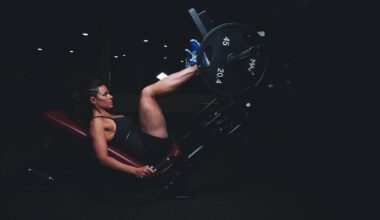Stretching Exercises to Minimize Kickboxing Injury Risks
Kickboxing is an exhilarating sport that challenges both physical and mental stamina. However, injuries can occur if proper precautions aren’t taken, particularly regarding warm-ups and stretching routines. Incorporating appropriate stretching exercises into your training can significantly enhance flexibility, balance, and overall physical endurance. This results in reduced injury risks during rigorous bouts. A structured approach to incorporating stretching into your kickboxing routine can help prevent strains and sprains, particularly to the hamstrings, groin, and shoulders. Furthermore, stretching promotes blood circulation and warms up the muscles, making them more pliable and receptive to physical exertion. Additionally, mental focus is sharpened through these exercises, as it helps practitioners connect with their bodies. Each stretch should ideally be held for 30 seconds and performed in a controlled manner, avoiding rapid movements that may lead to injuries. Include both dynamic and static stretches in your training sessions to maximize benefits. Visualize the changes in your body as you perform these techniques, ensuring you maintain proper form and posture. Over time, you will develop both the flexibility and strength needed to excel in kickboxing.
One effective stretching exercise to incorporate in your warm-up regime is the standing quadriceps stretch. To perform this stretch, stand on one foot and grab the ankle of your opposite foot, pulling it toward your glutes. Be sure to keep your knees close together and maintain a straight posture. This stretch targets your quadriceps, helping to improve mobility and decrease the likelihood of injury during the lateral movements common in kickboxing. Hold each side for around 30 seconds while breathing deeply to concentrate on relaxation. Conditioning your muscles before an intense kickboxing workout prepares them for the impact of punches, kicks, and rapid movement changes. Another beneficial stretch is the hip flexor stretch; kneel on one knee while pushing your hips forward to feel a stretch through your hip flexor and quadriceps. Repeat on both sides. Incorporating these stretches into your routine is essential to maintaining flexibility. Remember to perform these stretches while being mindful of your limits—never force a stretch as it may lead to injuries. Overall, consistency in stretching will contribute to better performance and fewer injuries in kickboxing.
The Importance of Dynamic Stretching
Dynamic stretching is a perfect way to enhance flexibility and warming up before kickboxing training sessions. Pre-workout stretches that involve progressive movements are more beneficial than static stretches, which one typically performs after workouts. Examples of dynamic stretches include high knees, butt kicks, and arm circles. Engaging in dynamic stretches prepares your muscles for the action ahead. Specifically, high knees elevate heart rates, warm up lower-body muscles, and enhance coordination. Start at a slow pace and gradually increase the speed for effectiveness. Butt kicks, on the other hand, involve jogging while trying to touch your glutes with your heels, which stretches your quads and engages your hamstrings. This particular exercise can also serve as an effective cardiovascular warm-up. Incorporating arm circles with your shoulder stretches is vital; aim to enhance shoulder mobility. Stand with your arms extended and rotate them in large circles, initially clockwise, and then counter-clockwise. Prepare to integrate these dynamic movements effectively in your kickboxing training for improved flexibility and fluidity during your performance.
The flexibility of your ankle joints may also influence your performance in kickboxing. Ankle mobility directly impacts balance and stability during kicks and footwork, which are key components of effective kickboxing. One critical stretch to incorporate is the calf stretch. Stand facing a wall with one foot forward and the other foot extended backward. Lean toward the wall while keeping the back heel on the ground. This position will stretch the calf muscle on the extended leg. Hold this posture for 30 seconds on each leg, feeling the stretch in your calf muscle. Not only does improving calf flexibility aid in executing kicks effectively, but it also minimizes the risk of falling during training or competitions. Ankle circles are another beneficial exercise; while seated or standing, elevate one foot and move your ankle in circular motions. This exercise enhances the mobility of both the ankle and foot, allowing for improved balance during movements. Regularly incorporating these ankle-focused stretches will significantly boost your kickboxing proficiency and decrease injury probability.
Incorporating Stretching into Cool Down Sessions
Understanding when to stretch is as crucial as the stretches themselves. Post-workout stretches promote recovery, alleviate soreness, and enhance overall flexibility. After completing your kickboxing session, take time to perform static stretches for each major muscle group used during workouts. Hamstring stretches, for example, can improve flexibility and lower the risk of post-workout injuries. To perform the hamstring stretch, sit with one leg extended and the other bent. Reach toward the toes of the extended leg while keeping your back straight and feeling a gentle stretch in the hamstring. Another valuable stretch is the figure-four stretch, targeting your glutes and hips. Lie on your back, cross one ankle over the opposite knee, and gently pull the uncrossed leg towards your chest. Hold these stretches for at least 30 seconds, allowing your muscles to relax and realign after intense movement. Contributing to the recovery phase will enhance your body’s capacity to adapt to training, enabling you to progress more effectively in your kickboxing journey.
Aside from the physiological benefits, stretching provides mental relaxation, reducing stress and promoting mindfulness. Stretching should never be seen as an ancillary activity but as an integral part of kickboxing. Incorporating an intentional breathing practice—the mindful connection of breath and movement—will enhance your overall workout experience. Start by finding a comfortable position, either standing or sitting, and focus your breathing. Inhaling through the nose, visualize filling your torso, then exhale slowly through the mouth. As you breathe out, think about releasing any tension you’re holding. This practice aligns with your stretching regime; as you hold stretches, synchronize your breath. This mindfulness technique can help alleviate anxiety and build emotional resilience, empowering you during rigorous sessions. Focus on serenity and patience during your stretching exercises; it’s not just about flexibility but also about improving concentrations. A regular stretching routine, supplemented by breathing techniques, will enable you to become mentally agile and physically prepared, which is essential for kickboxing success.
Final Thoughts on Stretching for Kickboxing
In summary, an effective stretching routine is paramount for anyone serious about kickboxing. The synergy between stretching and kickboxing performance cannot be overemphasized. It is essential to integrate both dynamic and static stretches targeting key muscle groups like quads, hamstrings, calves, and hips. Moreover, acknowledging the importance of ankle flexibility and incorporating cooldown stretching becomes vital for recovery. Not only does consistent stretching minimize injury risks, but it also aids in enhancing performance and overall capabilities in the ring. Practitioners should make stretching an integral aspect of their training regimen, realizing that flexibility plays a vital role in executing techniques efficiently while maintaining control and balance. Overall, kickboxers of all skill levels can greatly benefit from implementing a comprehensive stretching routine. With dedication and mindfulness in these activities, athletes will experience improved resilience over time. Ultimately, developing a consistent habit around stretching will ensure longevity in the sport, allowing kickboxers to enjoy this exciting discipline while minimizing the chances of sustaining injuries. Let this article inspire you to take your stretching routine seriously and make essential adjustments.
Kickboxing lends itself to both physical and mental conditioning, supporting personal growth. To reap the benefits of kickboxing without the associated injury risks, focus on integrated stretching routines. Start today and observe the transformation in your kickboxing journey.


